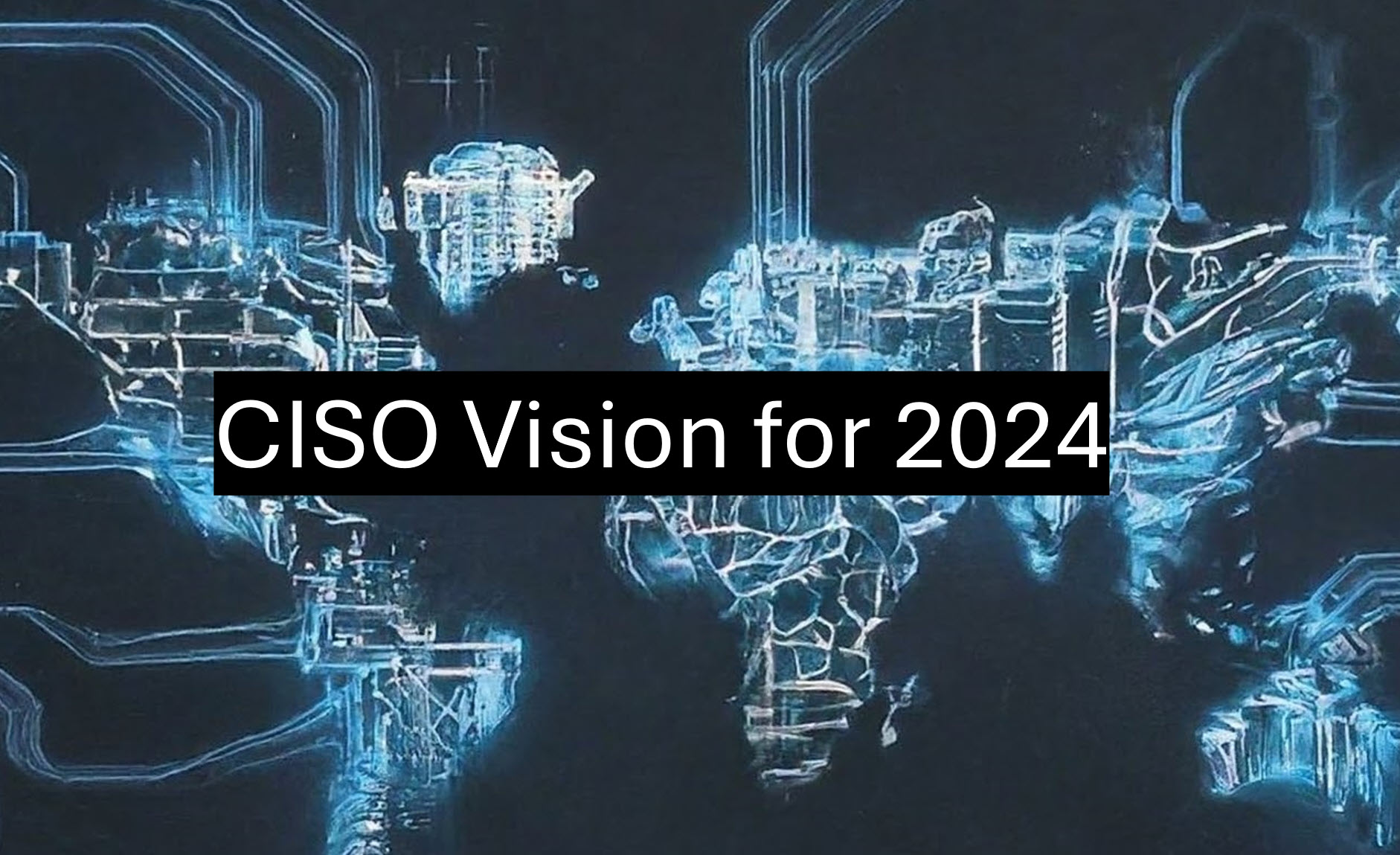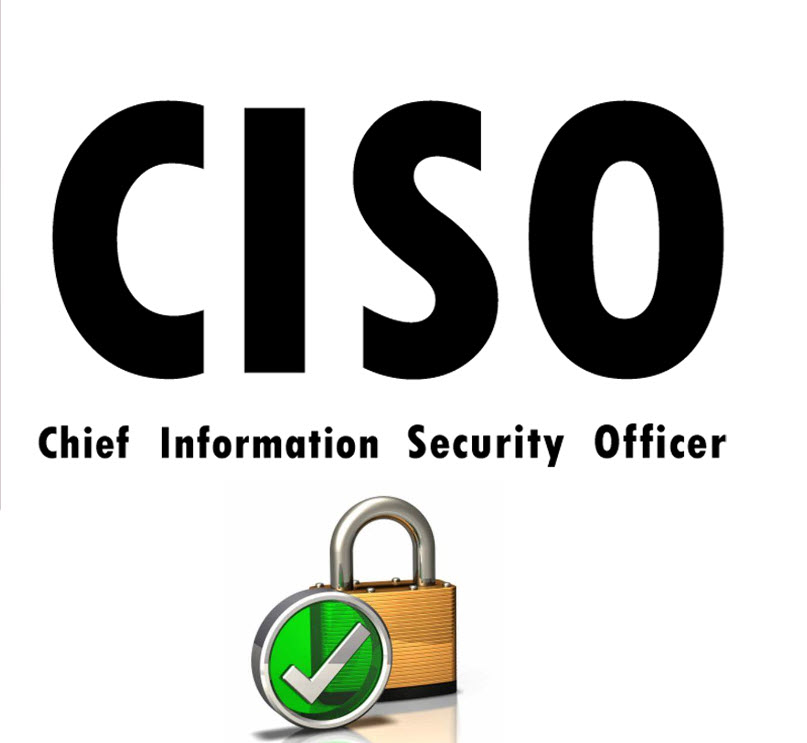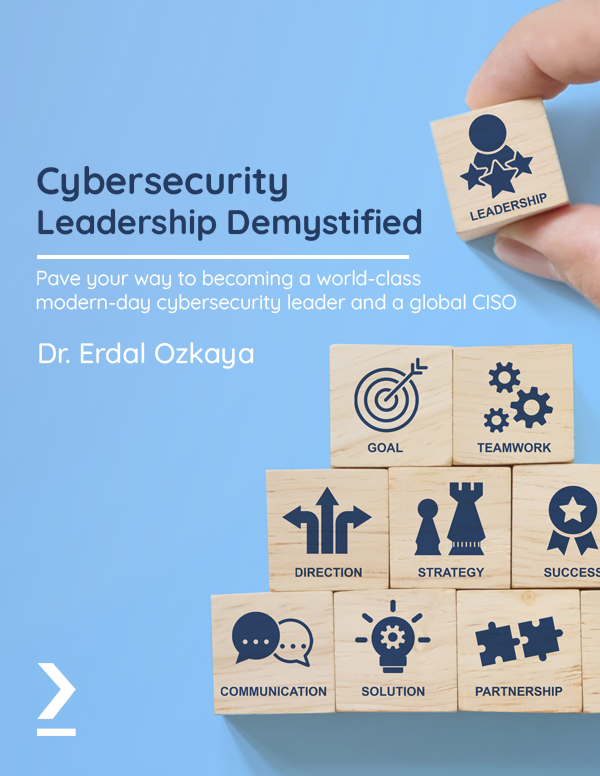
CISO Vision for 2024
CISO Vision for 2024 Navigating the Cybersecurity Landscape
As we move further into the digital age, the role of the Chief Information Security Officer (CISO) has become increasingly complex and pivotal to the success of any organization. The year 2024 presents new challenges and opportunities for CISOs to protect their organizations from emerging threats while supporting business growth and innovation.
The cybersecurity landscape is continuously evolving, with new threats emerging and existing threats becoming more sophisticated. In 2024, CISOs must not only be adept at managing these risks but also be visionary leaders who can anticipate future challenges and opportunities.
Strategic Vision
A CISO’s vision in 2024 should encompass the following key areas:
Aligning Cybersecurity with Business Objectives
CISOs must ensure that cybersecurity strategies are fully integrated with the organization’s business goals, facilitating secure growth and innovation.
Embracing AI and Machine Learning
Leveraging AI and machine learning can provide predictive insights into potential threats and automate responses to security incidents.
Fostering a Culture of Security
Creating a ‘Security First’ culture within the organization is essential. This involves educating employees about cybersecurity best practices and encouraging proactive security behaviors
Cloud Security and Hybrid Infrastructure
With the increasing adoption of cloud services, CISOs must focus on securing hybrid cloud infrastructures and managing associated risk.
Regulatory Compliance and Data Privacy
Staying ahead of regulatory changes and ensuring compliance is critical. CISOs should prioritize data privacy and protection to maintain customer trust.
Vendor Management and Ecosystem Partnerships
CISOs need to manage relationships with vendors effectively, ensuring that their products and services align with the organization’s security needs
Incident Response and Crisis Management
Developing robust incident response plans and crisis management strategies is crucial for minimizing the impact of security breaches.
Evolving Threat Landscape
- AI-Powered Attacks: Artificial intelligence (AI) will become increasingly sophisticated, weaponized by adversaries to evade traditional defenses. Proactive AI-based detection and mitigation will be required.
- IoT and OT Proliferation: The explosion of devices within operational technology (OT) environments creates new vulnerabilities and expands the attack surface. Segmented security approaches and real-time monitoring are vital.
- Targeted Ransomware and Deepfakes: Ransomware will remain a major threat, evolving towards more targeted, high-impact attacks. Deepfakes will also present growing challenges for authentication and disinformation.
Strategic Priorities
- Zero Trust Architecture: Transitioning to a Zero Trust framework that assumes ‘never trust, always verify’ will be a core focus for resilient network architectures. This includes micro-segmentation, context-aware access, and continuous authentication.
- Cloud-Centric Security: As organizations migrate to cloud infrastructure, security solutions must adapt accordingly. Investing in cloud-native security tools, secure configurations, and DevSecOps integration is key.
- Security at the Edge: With the rise of remote work and distributed assets, securing devices at the network’s edge is crucial. Endpoint protection, secure access controls, and mobile device management (MDM) must be comprehensive.
- Proactive Cyber Threat Intelligence: Building robust threat intelligence capabilities to detect emerging attack patterns and potential exploits is essential. This involves consuming threat feeds, sharing information, and integrating intelligence into defensive systems.
Technological Focus Areas
- AI and Machine Learning (ML) for Security: Leverage AI/ML for predictive threat detection, sophisticated anomaly detection, user behavior analytics (UBA), and automated threat response.
- XDR (Extended Detection and Response): Adopt XDR tools to provide centralized visibility, correlation, and automated response orchestration across endpoints, networks, cloud, and other assets.
- Data-Centric Approach: Emphasize data loss prevention (DLP), encryption, and data classification solutions to secure sensitive information throughout its lifecycle.
- Identity-Driven Security: Enhance identity and access management (IAM) with privileged access controls, multi-factor authentication (MFA), and zero-standing privilege models.
- Security Automation and Orchestration: Implement tools and processes to automate security tasks, incident response, and vulnerability management to improve efficiency and scalability.
- Advanced EndPoint Protection : Move from Detection to Prevention With ZeroThreat to isolate infections such as ransomware & unknowns
Beyond Technology: People and Culture
- Continuous Security Education: Establish ongoing, comprehensive security training programs that target all levels of the organization, fostering a security-aware culture.
- Cross-Departmental Collaboration: Break down silos between security and other departments (IT, Operations, Legal) to build a holistic security mindset throughout the organization.
- Risk-Based Board Communication: Develop clear, business-focused metrics to enable effective communication of cyber risk posture to executives and the board.
The vision for a CISO in 2024 is one of a strategic leader who can navigate the complex cybersecurity landscape, align security initiatives with business goals, and foster a culture of security awareness throughout the organization.
This blog provides a high-level overview of the strategic vision a CISO should have in 2024. It is based on current trends and expert predictions in the field of cybersecurity. For a more detailed analysis, further research and consultation with industry experts are recommended.
Read the article at Global CISO Forum , click here
For more Leadership articles

6 Facts you need to know about CISO’s
What is a CISO ?
A CISO, or Chief Information Security Officer, is primarily responsible for an organization’s cyber security initiatives. CISOs are technologists, who can participate in high-level initiatives as business strategists. CISO’s ensure that IT systems comply with security and regulatory requirements. In summary a C(I)SO is the top Cyber executive of an organization. The Role CISO requires a combination of technical and soft skills, such as business acumen, leadership, communications and relationship building.
WHAT EXACTLY IS A CISO ?
Before we dive deep into the nuances of cyber chiefs’ career paths, it’s important to understand the nature of the role. So here is the 6 Facts you need to know about CISO role :
- Trusted “security” advisor – As a CISO you need to translate technical matters into the language of the business – helping non technological executives and boards understand the technical matters and help them make risk-informed decisions confidently
- Strategist – As a CISO, you need to get involved setting goals, determining actions to achieve the goals, and mobilizing resources to execute the “prioritized” actions which needs to be tightly linked to businesses strategy.
- Leader – As a CISO you need to have leadership skills not just to build an inspired and bonded diverse team but also set an example as a role model to create culture of constant learning, innovation, and active collaboration.
- Modern Marketer –Modern marketing is the ability to harness the full capabilities of the business to provide the best experience for the customer and thereby drive growth. As a CISO you need to evangelize cybersecurity capabilities to regulators, client prospects, insurers, and business partners — helping win new business, lower cost of capital, and maintain the license to operate.
- Change agent – CISO’s should be able to create a cyber culture where everyone in the organization understand cyber risks and help you to mitigate them
- Influencer – CISO’s should be able to influence critical stakeholders to support the cybersecurity transformation.

How to Become a CISO
There is no direct path to the CISO role. While this is true, its really important to hire the right talent. Being a CISO used to be a hard core cybersecurity role, however, the function of the CISO involves much more business leadership and risk management.
Today, a CISO must be able to help executives at C-suite level to understand risk as it is about bits. CISOs in any enterprise organization must-have skills to be able explain security for non techies, build and maintain critical relationships and communicate at both senior and operational levels. Soft skills are critical to evangelizing security initiatives and celebrating wins, which need to be expressed as business outcomes.
Soft skills are critical to evangelizing the agenda and celebrating wins, which need to be expressed as business outcomes. The CISOs who can develop those skills can ‘sell security’ to their peers and other business line executives. So who can become a CISO ?
- Experienced techies, such as cybersecurity architects, network security engineers, or IT Security Managers
- An experienced technology risk manager
- A CIO or technology leader with extensive experience building high performing teams, driving digital transformation, and sitting on executive committees
Who should not become a CISO
As a trusted security advisor in the past, I met many CISO’s who had no clue about cybersecurity, and unfortunately those CISO’s needed the most help . CISO’s should not be just hired based on experience in the company, or for just being a program delivery manager. CISO’s are much more then just a delivery manager , politician or someone who is network well to get the “hot” seat which pays well. Mark my words, the organizations they follow tis path will have ex CEO’s which blame interns for using weak passwords. ( Read the news article here : https://edition.cnn.com/2021/02/26/politics/solarwinds123-password-intern/index.html )
I met many CISO’s depending on our “advisory” or they were great leaders but had no clue of “what was exactly happening in cyber landscape”
Areas of focus for a CISO

CISO Responsibilities
Some of the day to day tasks of CISO’s are :
Security Operations
Real-time analysis of immediate threats, and triage when something goes wrong.
Cyber-risk and Cyber Intelligence
Keeping abreast of developing security threats, and helping the board understand potential security problems that might arise from acquisitions or other big business moves.
Data Loss and Fraud Prevention
Making sure internal staff doesn’t misuse or steal data
Security Architecture
Planning, buying, and rolling out security hardware and software, and making sure IT and network infrastructure is designed with best security practices in mind.
Identity and Access management
Ensuring that only authorized people have access to restricted data and systems.
Program Management
Keeping ahead of security needs by implementing programs or projects that mitigate risks—regular system patches, for instance.
Investigations and Forensics
Determining what went wrong in a breach, dealing with those responsible if they’re internal, and planning to avoid repeats of the same crisis.
Governance
Making sure all of the above initiatives run smoothly and get the funding they need—and that corporate leadership understands their importance.
CISO Responsibilities:
- A CISO is appointed to provide cyber security leadership and guidance for their organisation.
- The CISO within an organisation is typically responsible for providing strategic-level guidance for their organisation’s cyber security program and ensuring compliance with cyber security policy, standards, regulations and legislation. They are likely to work with a Chief Security Officer, a Chief Information Officer and other senior executives within their organisation.
- The CISO oversees their organisation’s cyber security program and ensures their organisation’s compliance with cyber security policy, standards, regulations and legislation.
- The CISO regularly reviews and updates their organisation’s cyber security program to ensure its relevance in addressing cyber threats and harnessing business and cyber security opportunities.
- The CISO implements cyber security measurement metrics and key performance indicators for their organisation.
- The CISO coordinates cyber security and business alignment through a cyber security steering committee or advisory board, comprising of key business and ICT executives, which meets formally and on a regular basis.
- The CISO coordinates security risk management activities between cyber security and business teams
- Overseeing incident response activities
- Contributing to business continuity and disaster recovery planning
- Developing a cyber security communications strategy
- Working with suppliers and service providers
- Receiving and managing a dedicated cyber security budget
- Overseeing cyber security personnel
- Overseeing cyber security awareness raising
CISO : Cybersecurity Leadership Demystified by Erdal Ozkaya
My new book will , which is planned to be published in 2021 will be a desk reference book for CISO’s and everyone who wants to be CISO….
You can find the details at Amazon (when ready) :
You can find the details at Packt (when ready) :
The Essential 7 for CISO role?
As CISO – especially in a new organization – you need to balance between a Cybersecurity guru and business acumen. Of course you will need to start creating a cybersecurity strategy – or revise it if it exists – creating a budget , build your team but also spend time o manage the expectations of your stakeholders.
- Do you know what are you doing in your next 100 days Do you know all your assets , crown jewels – are they reflected in your 100 days plan ?
- What is your Incident Response Plan? Are you ready to recover from a cyber attack ? Did you asses the organization and presented the finding to the board?
- Are you up to date ? Did you prioritize the essential 10-15 critical few key controls, are they tested and ready for coverage and maturity?
- What is your scope? Are roles and responsibilities defined in writing and assigned to accountable executives and their teams ?
- Do you have a measurable cyber-resilient culture change program in place ? Don’t forget its CISO’s priority to work with the CEO/ Board and create a cyber culture organization wide , with Assume Breach in mind
- Do you know your key customers ? Did you start to reach them out and build / strengthen relation?
- Create / define your partners ! Leverage new innovations
CERTIFICATIONS
While certifications are good to show what you know, keep in mind that certifications don’t make one a stronger professional. Certifications won’t turn a CISO candidate from analyst to C-suite dweller overnight. But what they can do is offer expertise across the many areas CISOs must have basic knowledge of, if not in-depth expertise
- EC Council CCISO
- SANS Leading Cybersecurity Change , Build a Security based culture
- SANS Security Leadership Essentials for Managers
Based on a study by Digital Guardian 53 of the Fortune 100 CISOs held the CISSP (certified information systems security professional by (ISC)²) certification and 22 held the CISM (certified information security manager by (ISC)²) . The top five certifications held by Fortune 100 CISOs include CISSP, CISM, ITIL, CISA (Certified Information Systems Auditor by ISACA) and CRISC (Certified in Risk and Information Systems Control).
In Summary :
The CISO is the guardian of the organization, who build the cyber strategy be the advisor to the board and who is still a technical executive. CISO is also known as CSO (Chief Security Officer ) and VP of security.
The demand for business-centered technical CISOs will continue to grow, as having the right CISO will provide assurance to companies their strategic business partners, regulators, and customers that their cybersecurity capabilities are robust and fit for purpose.
And I for sure recommend you to aim to be a CISO as data breached soar, so will CISO’s paychecks.
If you want to learn more on how to be a CISO wait for my new book which should be published in Q4 2021.
Free resources
Global CISO Forum
The Global CISO Forum was launched on 26 May during GEC Media’s Security Symposium 2021. Anushree Dixit, Global Head Content & Strategic Alliances, GEC Media Group announced the launch of the forum. Dr Erdal Ozkaya, Management Member of Global CISO Forum gave a live overview of the Forum.
Global CISO Forum community aims to unite security leaders across the globe, who are active in, or interested in security policy, technology, standards, certification, success story and programs to accelerate the thoughtful adoption of security best practices across regional as well as global level.
The vision of the forum is as follows:
- Building an effective cyber security culture
- Securing the support of individual execs will help to build momentum behind cultivating a cyber security culture
- Addressing the challenges of building a security team
- Strategising staffing based on models, budget, and organisation goals
- Identifying talent gaps
- Knowledge through success stories
- Industry specific insights and sharing of best practices
Global CISO Forum Social Media Accounts :
LinkedIn: https://www.linkedin.com/company/global-ciso-forum
Twitter : https://twitter.com/GlobalCISO
Instagram: https://www.instagram.com/globalciso/
Facebook : https://www.facebook.com/globalciso
To Visit Global CISO Forum
To Visit Global CISO Forum from your mobile Phone
To read the news article :
To Read CISO Related blog posts
You can watch many CISO related videos in my YouTube channel
How CISO’s can reduce Risk ?
Keywords
future of cybersecurity ciso executive summit cisos in 2024 fireside chat chair learn more looking What is the goal of the CISO? What is the mission of the CISO? What is the new role of the CISO? What is the expanding role of the CISO?





